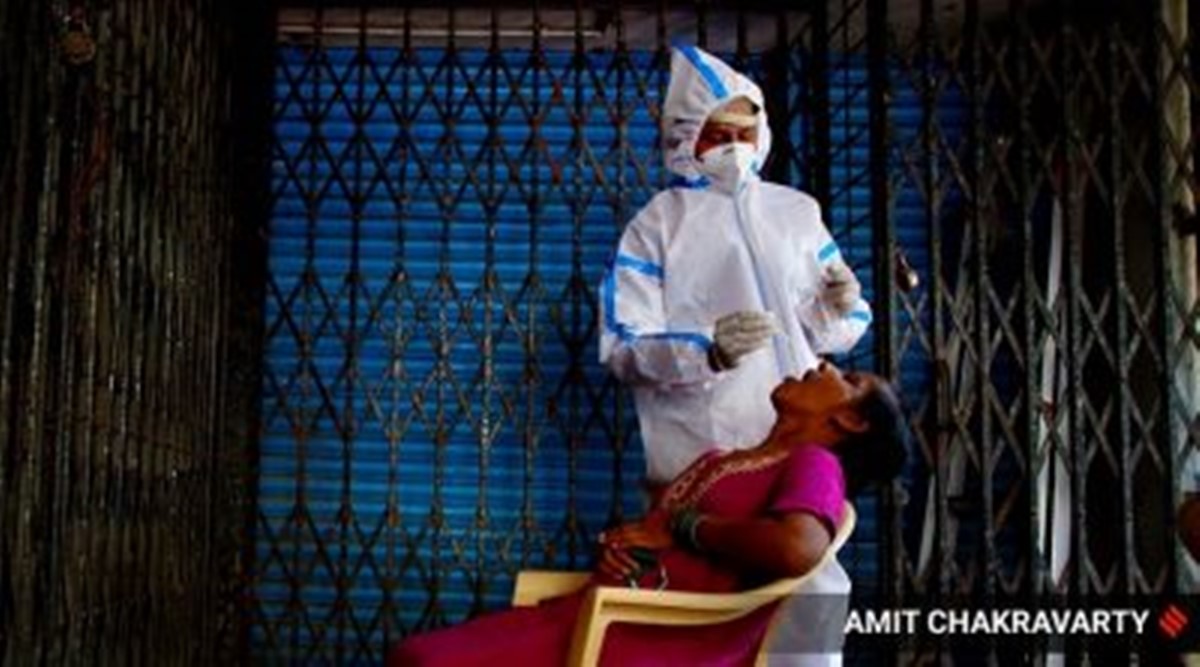 The ward data shows 1.92 per cent of those who undergo antigen tests and 6.23 per cent of those who undergo RT-PCR tests are detected positive for Covid-19 in this ward. (Express Photo)
The ward data shows 1.92 per cent of those who undergo antigen tests and 6.23 per cent of those who undergo RT-PCR tests are detected positive for Covid-19 in this ward. (Express Photo) The eastern suburbs of Mumbai are emerging as new hotspots for Covid-19 with a spike in active cases and a rising weekly growth rate indicative of a faster spread of the infection. Three wards — M West, T and S ward— covering Govandi, Mankhurd, Mulund and Bhandup, have shown a rise in cases.
A surge in cases was expected after reopening of trains.
The Brihanmumbai Municipal Corporation (BMC) plans to make rules for masks and physical distancing stringent in pockets with high growth rate.
Until December, it was the western suburbs that showed maximum burden of cases. Over the last few days, the eastern suburbs have emerged as new hotspots. The BMC has moved quickly to seal a number of buildings in these areas. The maximum containment zones in slums and chawls are in Ghatkopar (N ward) where 14 slums have been declared contained zones, and 10 slums in Bhandup, Vikhroli (S ward). In terms of sealed buildings, Ghatkopar has 160 and Mulund (T ward) has 202 floors or buildings sealed, the highest in the city.
T ward, S ward and N ward covering Mulund, Bhandup, Vikhroli, Ghatkopar are also among eight wards that have so far seen more than 15,000 Covid-19 cases each. Other wards are R-Central (Borivali), R South (Kandivali), P North (Goregaon), K West (Andheri West) and K East (Andheri east).
While western suburbs continue to report maximum active infections, eastern wards have slowly started showing rise in fresh cases. Govandi and Mankhurd slums, falling under M-West ward, have highest weekly growth rate in Covid-19 cases at 0.26 per cent, followed by Mulund at 0.25 per cent. The average of the city is 0.15 per cent.
T ward Assistant Commissioner Kishore Gandhi said the rise in new infections is expected to continue for the next 20-22 days. “Every time there is an unlock, cases rise for the next 15-20 days. The reopening of trains has had the same effect. The rise in cases is not alarming yet,” said Gandhi. The ward records 30-50 new cases every day. Every day, 250-300 people violating rule of face masks are penalised.
In M-West, Medical Officer Dr Bhupendra Patil said the rise in cases is noticeable since one week, about 98 per cent cases are from non-slums. “We have been seeing consistent cases in Tilak Nagar since September. We have now begun house-to-house survey to find symptomatic cases and test them,” Patil said.
The ward data shows 1.92 per cent of those who undergo antigen tests and 6.23 per cent of those who undergo RT-PCR tests are detected positive for Covid-19 in this ward. The RT-PCR positivity rates in M-West ward are much higher than the city’s average, which hovers below 6 per cent.
Mumbai noted a 24.3 per cent rise in daily cases between first and second week of February. Local trains started operations for general public on February 1. While Covid-19 cases have increased, the daily testing numbers are yet to pick up pace. Mumbai tests between 12,000 and16,000 people in a day.
Since the case growth rate in M-West is highest in the city, ward officials have asked housing societies to check temperature of all visitors, limit entry of outsiders, get symptomatic residential members tested for Covid-19 and if possible, allow only domestic helps, milkman and newspaper delivery men into the premises.
“We have increased the number of containment zones and if cases continue to rise, the measures will be made stricter. Currently, we are noticing several social events with mass gatherings like marriages and family functions, where people do not follow Covid-appropriate behaviour,” Medical Officer Patil added.
Residents have also been warned of small-scale lockdown in streets where a cluster of cases are reported. Till now, such a situation has not been noticed.